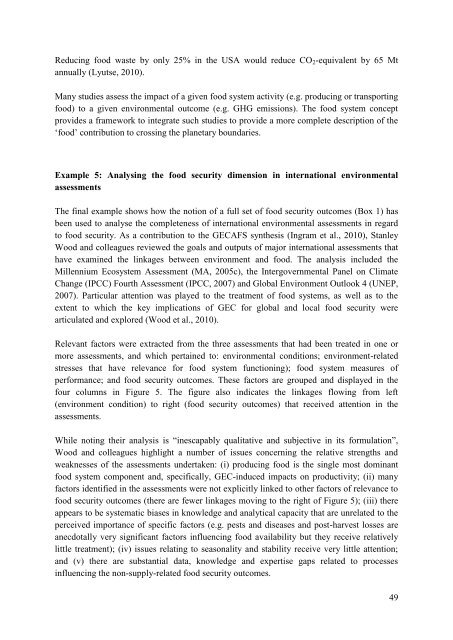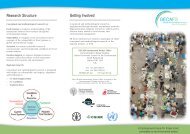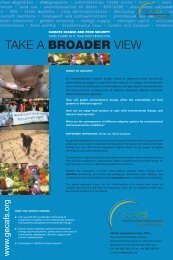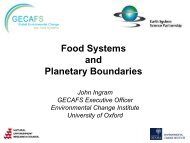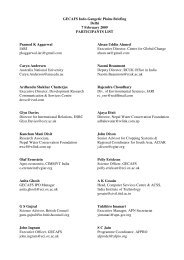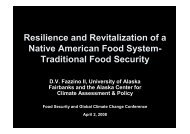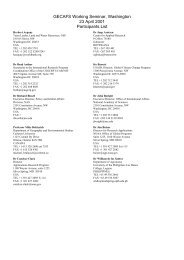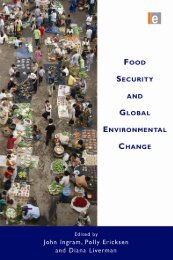From Food Production to Food Security - Global Environmental ...
From Food Production to Food Security - Global Environmental ...
From Food Production to Food Security - Global Environmental ...
- No tags were found...
You also want an ePaper? Increase the reach of your titles
YUMPU automatically turns print PDFs into web optimized ePapers that Google loves.
Reducing food waste by only 25% in the USA would reduce CO 2 -equivalent by 65 Mtannually (Lyutse, 2010).Many studies assess the impact of a given food system activity (e.g. producing or transportingfood) <strong>to</strong> a given environmental outcome (e.g. GHG emissions). The food system conceptprovides a framework <strong>to</strong> integrate such studies <strong>to</strong> provide a more complete description of the‘food’ contribution <strong>to</strong> crossing the planetary boundaries.Example 5: Analysing the food security dimension in international environmentalassessmentsThe final example shows how the notion of a full set of food security outcomes (Box 1) hasbeen used <strong>to</strong> analyse the completeness of international environmental assessments in regard<strong>to</strong> food security. As a contribution <strong>to</strong> the GECAFS synthesis (Ingram et al., 2010), StanleyWood and colleagues reviewed the goals and outputs of major international assessments thathave examined the linkages between environment and food. The analysis included theMillennium Ecosystem Assessment (MA, 2005c), the Intergovernmental Panel on ClimateChange (IPCC) Fourth Assessment (IPCC, 2007) and <strong>Global</strong> Environment Outlook 4 (UNEP,2007). Particular attention was played <strong>to</strong> the treatment of food systems, as well as <strong>to</strong> theextent <strong>to</strong> which the key implications of GEC for global and local food security werearticulated and explored (Wood et al., 2010).Relevant fac<strong>to</strong>rs were extracted from the three assessments that had been treated in one ormore assessments, and which pertained <strong>to</strong>: environmental conditions; environment-relatedstresses that have relevance for food system functioning); food system measures ofperformance; and food security outcomes. These fac<strong>to</strong>rs are grouped and displayed in thefour columns in Figure 5. The figure also indicates the linkages flowing from left(environment condition) <strong>to</strong> right (food security outcomes) that received attention in theassessments.While noting their analysis is “inescapably qualitative and subjective in its formulation”,Wood and colleagues highlight a number of issues concerning the relative strengths andweaknesses of the assessments undertaken: (i) producing food is the single most dominantfood system component and, specifically, GEC-induced impacts on productivity; (ii) manyfac<strong>to</strong>rs identified in the assessments were not explicitly linked <strong>to</strong> other fac<strong>to</strong>rs of relevance <strong>to</strong>food security outcomes (there are fewer linkages moving <strong>to</strong> the right of Figure 5); (iii) thereappears <strong>to</strong> be systematic biases in knowledge and analytical capacity that are unrelated <strong>to</strong> theperceived importance of specific fac<strong>to</strong>rs (e.g. pests and diseases and post-harvest losses areanecdotally very significant fac<strong>to</strong>rs influencing food availability but they receive relativelylittle treatment); (iv) issues relating <strong>to</strong> seasonality and stability receive very little attention;and (v) there are substantial data, knowledge and expertise gaps related <strong>to</strong> processesinfluencing the non-supply-related food security outcomes.49


